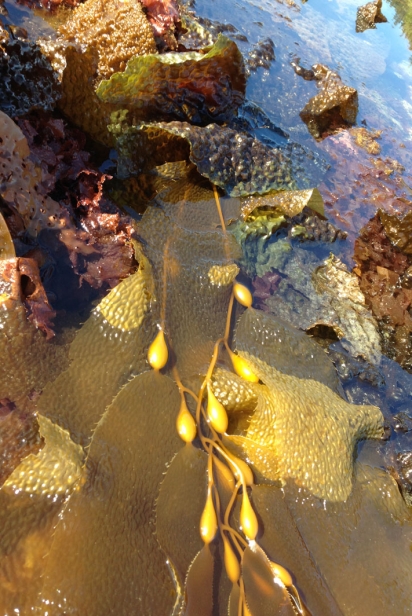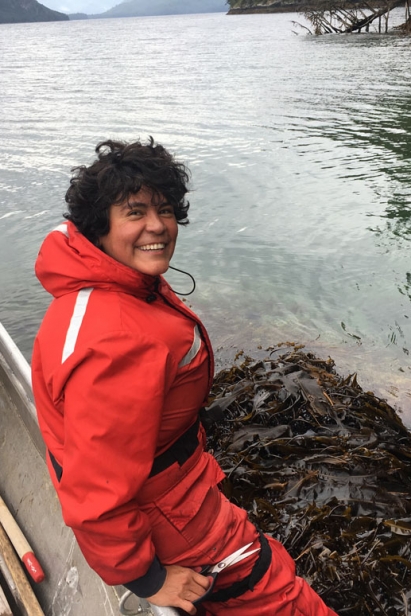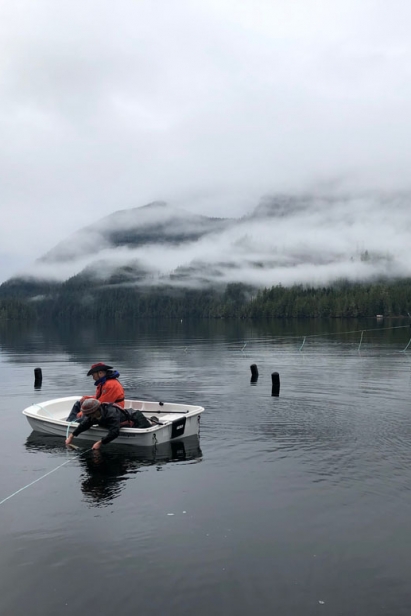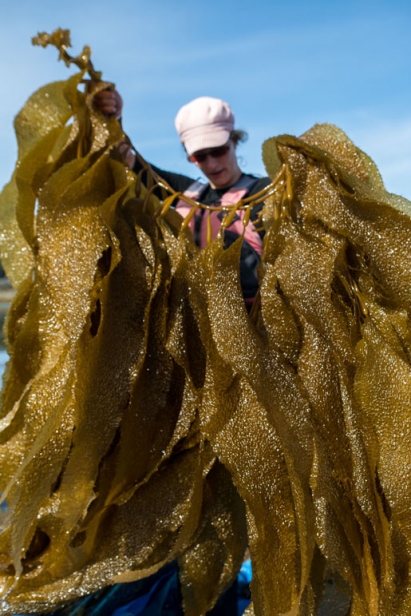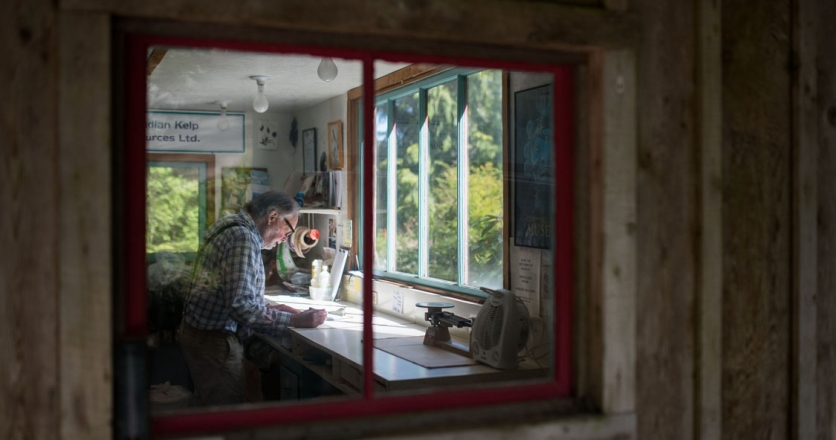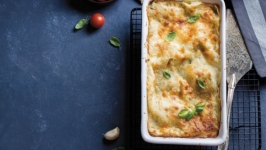Cultivating Kelp
Kelp is the new kale!” shouted headlines a few years ago. And then...silence. The promised kelp revolution has not yet transformed B.C.’s West Coast. But it will. We have everything we need to fall in love with kelp.
And what’s not to love? If you're craving a healthier fix for your salt tooth, then kelp is your veggie. But it's also much more than that.
When you eat kelp, you get a tasty superfood with a range of health-enhancing properties: Omega-3s, fibre, iodine, vitamin B and protein. It boasts an impressive cultural pedigree — people have been eating it for thousands of years. Plus, when cultivated it's an amazing crop that can also be used as harm-free fertilizer, livestock feed, biofuel, biodegradable packaging and more.
Best of all, kelp saves the world by cleansing the ocean. The more we grow, the bigger we win. As Bren Smith, executive director and co-founder of GreenWave regenerative ocean farming, explains, kelp cultivation not only creates ideal growing conditions and habitats for many forms of sea life, it also filters out the toxins polluting oceans from agricultural, urban and industrial run-off. Kelp's rapid lifecycle means that when cultivated, there's no danger of overharvesting. Author Michael Pollan dubs this growing method a "revolutionary new model."
As the 2020 Seaweed Manifesto from the United Nations’ Global Compact so eloquently states: “Seaweed has the potential to address some of the world’s most pressing challenges... The aim is to restore abundance to the ocean, while solving some of the world’s biggest societal challenges.”
Kelp might be the answer
In British Columbia, we’re a little late to this party. While Asians and coastal Indigenous peoples have long made use of kelp — a brown seaweed — settler cultures have largely ignored its bounties, which must have taken some effort, since B.C. has the most diverse variety of kelp species in the world. Admittedly, it takes a leap of faith to stare at clumps of brown weeds strewn along the beach and imagine them as dinner. But today’s visionary chefs are rebranding the superfood as “sea vegetables” and fine diners are eating it up.
You might be more familiar with the gateway seaweed, nori. It encases our sushi and, as a processed treat, becomes those crunchy green squares in plastic boxes. But there’s more to seaweed than sushi and snacks.
One of the latest, greatest adaptations of seaweed for the Western diet is using kelp as a sustainable vegan food that packs concentrated protein and nutrients. Kelp also provides the best vegetarian umami kick around. It’s gluten-free and low-carb, making it suitable for those embracing the keto way. Plus kelp gives those forced to reduce their sodium intake a delicious, low-sodium alternative to table salt.
Kelp provision has been the domain of Asia until lately, but that’s changing. Dafne Romero, founder of North Pacific Kelp Wild Foods, is a veteran wild kelper whose knowledge is fuelled by passion. “Kelp is our ocean forest,” she says. "I think of it as the ocean's lungs."
Originally from Mexico, Romero moved to Montreal to study film, but she also ended up training as a cook and opened her own Mexican/French restaurant. She moved to Vancouver to work in the film industry and was lured to Haida Gwaii by friends in 1999. She never left.
“I felt I had a spiritual connection to this place,” she explains. “I knew I needed to be here for a reason.” That reason turned out to be kelp.
Maybe that's because as a child she loved gardening and cooking with her grandmother, who grew most of her own food and prepared everything from scratch. As well, Romero has been foraging wild foods as long as she can remember.
Living on Haida Gwaii, kelp was a natural fit. Romero had no trouble imagining kelp as food. “I ate it right away,” she says. “The Haida have a saying: ‘When the tide is out, the table is set.’ It’s so true.”
In the pristine waters of one of the world’s most diverse ecosystems, Romero carefully, respectfully and sustainably harvests small amounts of wild kelp in harmony with the environment and the Indigeous Haida Gwaii peoples.
Her products sell through specialty retailers such as Local Harvest or online from the North Pacific Kelp Wild Foods and Vegan Supply Co. websites. She also sells at several Vancouver farmers’ markets now that she spends part of the year on the Lower Mainland.
Besides driving the boat, pulling in the wild harvest, operating the processing plant and shipping out orders, Romero helps raise kelp’s profile. She tells her clients about its benefits and how easy it is to use: simply sprinkle kelp flakes over rice, salad and pasta, she suggests. She describes how to infuse smoothies, dips and muffins with kelp powder. “Some people need a nudge,” she says, suggesting that kelp powder and flakes can be starting points. “But many of my customers are already familiar with kombu and wakame as staples in Japanese cuisine.”
It really is easy to incorporate kelp into your life and meals. That’s why her next step is putting on her chef's hat to teach people how to cook with whole kelp — everything from seaweed salad and pesto to kombu broth and wakame in soup. And then there’s her signature dish, kelp lasagna, which she’ll soon be selling fully prepared and ready to heat up at home. Watch for it at Vancouver’s Skipper Otto, another sustainable B.C. initiative.
Her enthusiasm is expanding from culinary to agricultural and environmental. She’s learning how to grow some of her own kelp supply, starting with a consultation from Louis Druehl, founding father of kelp farming in B.C. and the first person to cultivate kelp outside of Asia. “I read Louis’s book on seaweed and it changed my life,” Romero says. “He’s my inspiration and my mentor.”
Druehl, who could be called the king of kelp, has been running Canadian Kelp with his wife, Rae Hopkins, for the past 37 years. He also taught marine botany at Simon Fraser University (SFU)for 36 years.
But Druehl grew up landlocked on a small farm in Utah, where he raised beef cattle in the Future Farmers of America club during high school. He yearned to be a farmer and studied veterinary sciences at university. There he discovered his passion for plants, particularly marine plants, which propelled him into his distinguished academic career researching and teaching about kelp. Along the way, the provincial government hired him in the early 1980s to develop a method for effectively cultivating kelp in B.C. Druehl’s method is still used today.
He uses it himself at Canadian Kelp. His wife jokes that he finally has a farm, but they harvest wild kelp, too.
Although seaweed can be used for many purposes, most of Canadian Kelp’s sea vegetables find their widest and most appreciative audience with those who shop in small health food stores or online directly through Canadian Kelp. A few years ago, the company’s restaurant sales increased dramatically when local seaweed became trendy in high-end eateries.
Druehl discovered how delicious kelp is when he travelled to Japan during his first sabbatical, in the 1970s. “I went to study kelp, not eat it, but it was part of the whole cultural experience,” he says. He and Hopkins now eat kelp every day. “We enjoy it dried, like you see it in the package.” They’re especially partial to macrocystis and bull kelp.
“My favourite is kelp chips,” he admits. “You take a piece of macrocystis and throw it into a hot frying pan. Just throw it in, then flip it over and take it out. It turns bright emerald and it’s a delicious snack. It’s like a potato chip, but it has potassium and other elements, plus micronutrients. You get a real umami flavour kick.”
Ever the scientist, Druehl won’t speculate on whether kelp’s many beneficial qualities help fuel his amazingly active “retirement,” but he admits it can’t hurt. He may be officially retired from SFU, but he still provides consultations and teaches workshops on kelp cultivation, and he’s still active in kelp conservation research. What’s more, he runs the local newspaper — and he writes books. He’s well-known for the award-winning, bestselling guide Pacific Seaweeds(co-authored with Bridgette E. Clarkston). His novel Cedar, Salmon and Weed reveals the nuances of small-town, remote Bamfield, where he’s been researching for decades and now lives full-time.
All of that is in addition to his work with Hopkins at Canadian Kelp. The couple has deliberately kept the company the size of a “mom and pop shop” so they can do all the work themselves. Their motto is, “From the beach to the shelf,” and they cultivate, harvest, process, package and ship orders. “We love it,” Druehl insists. “The people we meet through seaweed are amazing.”
The couple also participates in non-profit conservation work. They’ve been assisting in re-introducing bull kelp to coastal B.C. waters for years. Now, “we’re doing pioneering work looking at how to re-introduce giant kelp beds,” Druehl says. “They’re extremely important for fisheries because they provide an architecture, a habitat for fish and varied sea life — and this affects the entire food chain.” Druehl explains that giant kelp (the common name for macrocystis) is disappearing in many locations, which is detrimental to the entire marine environment.
The project is housed at Canadian Kelp, but they’re also working with the Bamfield Marine Science Centre and in discussion with the Huu-ay-aht First Nation to pilot the regeneration program.
All these impressive accomplishments ensure that Druehl is widely recognized in the seaweed world. In fact, Cascadia Seaweed — the newest kelp kid on the block — even calls him the “godfather of cultivation.” He’s been an integral piece of the puzzle for its team, providing his expertise as the new company scales the kelp-growing learning curve.
The three founders of Cascadia Seaweed may have diverse backgrounds, but their collective experience in marine geology (Bill Collins), naval engineering (Mike Williamson, former commander of CFB Esquimalt) and oceanography, environmental consulting and sustainable energy (Tony Ethier) means they not only know their way around the ocean, but also recognize a surefire win when they see one. The combined health, social, economic and environmental benefits of seaweed farming inspired this dynamic trio to jump into the deep end of kelp production.
Channeling an “if you grow it they will come” mentality, they began with two kelp farms of one hectare each, for a total growing area the size of two football fields. These “fields” are fully licensed by the provincial government, located in the pristine waters of Barkley Sound and operating in collaboration with First Nations partners.
Planting only native species, Cascadia Seaweed harvested its first crop this spring. Once its recent licensing request to expand to 20 hectares is accepted, Cascadia plans to establish new kelp fields in the fall and harvest up to 500 tons of the highest quality food-grade kelp in the spring of 2021. For now, the owners are focusing on well-established, high-demand varieties such as sugar kelp, alaria and dulse.
While Romero at North Pacific Kelp Wild Foods and Druehl at Canadian Kelp remain content with their small-scale endeavours, Cascadia Seaweed is already the largest ocean kelp cultivator on the Canadian West Coast, and it's only getting bigger. That's great news, since seaweed is one of the few crops that the more you grow, the better it is for the Earth.
This is the future of food. It's zero input to grow, causes no harm to harvest, and creates the most sustainable, affordable food on the Earth.
The worldwide demand for seaweed — especially as a food source — far exceeds supply. If that’s not yet the case in B.C., interest will surely boom once Cascadia Seaweed launches its brand of ready-made seaweed salads and snacks. In the meantime, North Pacific Kelp Wild Foods and Canadian Kelp offer plenty of sea veggies for kelp lovers to enjoy.
Canadian Kelp Resources
Port Desire, Bamfield B.C.
canadiankelp.com | 250.728.3297 | @canadiankelp
Cascadia Seaweed
9774 Third Street, Sidney, B.C.
cascadiaseaweed.com | 250.514.8581 | @cascadiaseaweed
North Pacific Kelp Wild Foods
1201 Oceanview Drive, Queen Charlotte, B.C.
northpacifickelp.com | 250.637.1489 | @northpacifickelp
Three reasons to eat more kelp:
Iodine: Seaweed is an excellent source of iodine. Sprinkling kelp powder or flakes onto the food you’re already eating is a quick, easy way increase your iodine levels, which can help improve thyroid function.
Fibre: Seaweed is incredibly high in fibre — soluble and insoluble. Increasing dietary fibre can help aid digestion and reduce the risk of diabetes.
Omega-3s: You don’t have to eat fish (or swallow fish oil supplements) to get your Omega-3s; you can get them straight from the same source the fish do — kelp. Increasing Omega-3s can reduce the risk of cardiovascular disease and inhibit cholesterol build-up.



